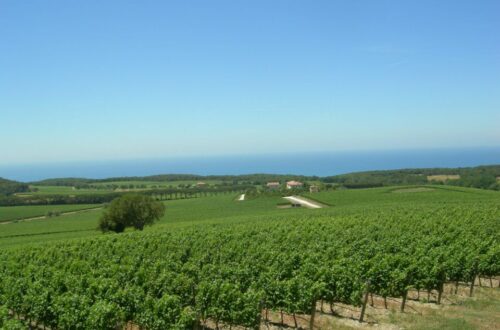Table of Contents
- What is Marsala DOC?
- History & Origins
- Where It’s Made: Geography & Terroir
- The Grape Blends
- Winemaking & DOC Regulations
- Key Facts at a Glance
- Tasting Notes
- Serving, Cooking & Pairing
- Marsala vs Other Fortified Wines
- Best Producers & Profiles
- Storage & How Long It Lasts
- Marsala Wine Tourism
- Where to Buy & Pricing
- FAQ on Marsala DOC
- Fun Facts & Cultural Notes
1. What is Marsala DOC?
Marsala DOC is a distinguished fortified Italian wine from Sicily’s Trapani province, made using local grapes like Grillo, Catarratto, and Inzolia. Available in styles from dry to sweet with alcohol levels between 15–20%, Marsala is traditionally aged using solera-like methods and offers distinctive amber, gold, and ruby tones. Serve dry styles chilled with cheese, and sweet ones at room temperature with desserts. WikipediaWineFrog
2. History & Origins
First fortified by English merchant John Woodhouse in 1773 to preserve it during sea voyages, Marsala gained popularity in England and beyond. In 1833, Sicilian pioneer Vincenzo Florio consolidated production, intertwining Marsala’s identity with his legacy. The Marsala DOC was officially granted in 1969. WikipediaWikipedia
3. Where It’s Made: Geography & Terroir
Produced around the coastal city of Marsala in western Sicily, the DOC benefits from a Mediterranean climate—sun-drenched vineyards cooled by sea breezes and enriched by varied soils that lend the wine both complexity and balance. WikipediaThe Guardian
4. The Grape Blends
White grapes—Grillo, Catarratto, Inzolia, and Damaschino—form the backbone of Marsala. The red Rubino style incorporates Nero d’Avola or Perricone up to 70%. Each blend yields unique color and aromatic profiles. WikipediaThe Guardian
5. Winemaking & DOC Regulations
Marsala styles are defined by color (Ambra, Oro, Rubino), sweetness (secco, semisecco, dolce), and aging (Fine – 1 yr; Superiore – 2 yrs; Superiore Riserva – 4 yrs; Vergine/Soleras – 5–10+ yrs). Aging in solera systems mirrors sherry production, building layered complexity. Wikipedia+1WineFrog
6. Key Facts at a Glance
| Item | Detail |
| DOC Established | 1969 |
| Region | Marsala, Trapani, Sicily |
| Grape Varieties | Grillo, Catarratto, etc. |
| Styles | Secco to Dolce; Fine–Vergine |
| Alcohol Content | 15–20% |
| Aging Technique | Solera or static systems |
7. Tasting Notes
Fine Secco offers dried fruits, almond, and honey tones.
Semisecco Oro reveals caramel, fig, and toffee.
Vergine Riserva delivers walnut, tobacco, dry citrus, and warming spice. Food & WineWikipedia
8. Serving, Cooking & Pairing
- Drink: Sweet Marsala at room temperature; dry styles lightly chilled.
- Pair with: Aged cheeses, mushrooms, caramel desserts, and chicken Marsala.
Cooking uses: Ideal in savory dishes like pan sauces and risotto; also enhances desserts. Food & WineWikipediaSouthern Living
9. Marsala vs Other Fortified Wines
| Wine | Region | Sweetness | Aging Technique |
| Marsala | Sicily | Varies | Solera/static |
| Sherry | Andalusia, Spain | Varies | Solera + flor |
| Port | Douro, Portugal | Mostly sweet | Half-fermented |
Marsala stands out with Mediterranean grape profiles and versatile styles. The Epicentrewinelovermagazine.comWikipedia
10. Best Producers & Profiles
- Cantine Florio – Historic estate founded 1833, known for both sweet and dry Marsala. Wikipedia
- Cantine Pellegrino – Established in 1880, offers accessible Superiore Dry. Wikipedia
- Marco de Bartoli – Artisan producer revered for elegant, nuanced bottlings. Food & Wine
11. Storage & Shelf Life
Marsala keeps well open—dry styles remain vibrant for weeks; sweet styles can last months if stored in a cool, dark place. Food & WineReddit
12. Marsala Wine Tourism
Explore Marsala through cellar tours at Florio, Tonnara visits, or tasting rooms like Donnafugata and Martinez. A great stop for wine enthusiasts in Sicily. RedditFood & Wine
13. Where to Buy & Pricing
Expect retail prices between €10–30 ($12–35 USD). Notable labels are widely available through specialty wine shops and online retailers.
14. FAQ on Marsala DOC
Is Marsala always sweet? No—styles range from dry to dessert-sweet.
Can Marsala age further at home? Yes, reserve styles can develop complexity over years.
How long does it last post-opening? Weeks to months, thanks to fortification.
15. Fun Facts & Cultural Notes
- Marsala’s name comes from the Arabic “God’s harbor.” Wikipedia
- It rose to fame through exports disguised as medication by Vincenzo Florio. The Guardian
It experienced a renaissance—no longer just for cooking, but celebrated as a sipping gem. Food & WineThe Guardian
Internal Linking Suggestions
- Link Sicily wine region
- Link fortified wine education article
Link Italian cooking guide, especially sauces
External Linking Suggestions
- Italian Wine Central—Marsala DOC profile
- Epicure & Culture article—Marsala vs other fortified wines
- Guardian piece on Sicilian wine renaissance The Guardian


